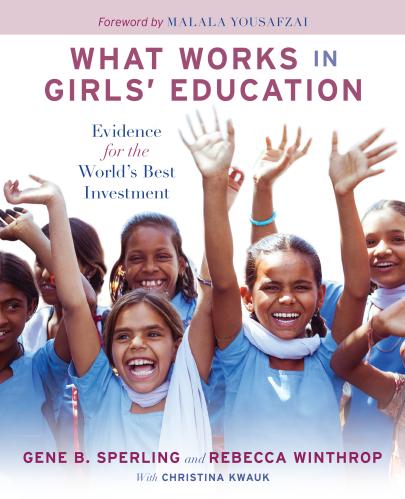As we observe the 3-year mark of Boko Haram’s kidnappings of 276 schoolgirls, and in light of the recent additional kidnappings of 22 girls, we are again reminded of the deepening link between violent extremism and girls and women. We are not the only ones noting these dimensions. The Council on Foreign Relations, a New York based Think Tank, for instance, is asking how women’s participation in conflict prevention can be a mitigating force. Journalist organizations like News Deeply have launched an entire series devoted to exploring women’s multi-faceted dimensions of engagement in extremist violence. And at the Center for Universal Education at Brookings, we are wondering how education in and outside of schools fits into this pressing discussion.
Last year, UNICEF shared alarming findings from a study of bomb attacks across Nigeria, Niger, Chad, and Cameroon: 3 out of 4 child suicide bombers are girls and 18 percent of all suicide bombers are women. As we progress in getting the most marginalized girls into school across the globe, we are alarmed that some of the most vulnerable girls in conflict-ridden areas are becoming precariously tied to extremism. But within the global education community, and much less within the peace and security community, the intersections between girls’ education and violent extremism are seldom discussed. Below, we outline a few points that we think could kick-start a conversation.
- Violence against girls: If girls’ education is brought up in discussions about extremism, it is usually because it serves as the backdrop to violence against girls and women. The mere act of pursuing an education can be life threatening for girls amid political turmoil, as the 2012 attack against Malala Yousafzai helped bring to light. Familiar stories of girls as victims of conflict—being threatened and abducted from their homes and schools, taken as sexual slaves, or forced to marry militants—fill our news feeds regularly. Research tells us that women and children are particularly vulnerable to human trafficking, sexual violence, and exploitation in crisis settings where many militant groups operate. Militant recruiters often target girls because they tend to be unsuspected by communities and law enforcement and are considered more malleable than boys. And in contexts where unaccompanied orphans and children travel toward resources and safety, these risks are intensified.
- Vulnerability and choice: A less discussed point is how girls and women bear the greater burden of poverty, creating the perfect storm for girls to turn to groups that may offer viable relief. In short, their vulnerability may lead them to join militant groups. This may be due to ideological motivations, but evidence also suggests that access to education may be another factor at play.
A 2015 study by the U.N. Organization Stabilization Mission in the Democratic Republic of the Congo found that some girls in the Congo joined militant groups under false promises of education, work, or money, which reveals their desperation to improve their future and immediate circumstances. Last year, Child Soldiers International learned from interviewing 150 girls that many chose to join militias after being kicked out of school for not paying fees, or because of lack of access to education altogether. Emerging evidence also suggests that even relative deprivation may drive radicalization among youth who have high access to education, but whose expectations about the returns to education do not align with corresponding opportunities. This highlights how (the lack of) access to educational opportunity can compound economic vulnerability in ways that make joining a militant group the lesser of two evils for girls just as much as it can for boys.
- Reintegration: When recruited or taken, girls spend between a few days to four years in militant groups, and when they return home, reintegration is an enormous feat. Soldiers have impregnated many, and both the girls and their children face immense discrimination from their communities. In light of increased female perpetration of violent attacks, communities are suspicious and fearful when girls return home, particularly if they are a militant’s wife. Even other abductees have been reported to verbally abuse and harass former militants’ wives. In refugee camps, education and other public goods becomes even less accessible to women and their children due to these suspicions, compounding the obstacles they face to reintegrating into society in a healthy way.
As we think about the girls who survived the Chibok kidnappings and the many others who have returned home after abduction with and without children, we must think about the psychosocial aftermath of the violence as much as preventing extremism. The American University of Nigeria is one such organization doing work to help reintegrate girls who escaped from Boko Haram. In addition to offering scholarships to survivors, AUN offers trauma counselling to girls struggling with the aftermath, including guilt from having left their fellow captives. The point here is that girls’ education is a critically important component of not only returning the girl to a sense of normalcy, but supporting her to be able to take back her life.
- The broken promise of education: Too often, we frame girls’ education as a silver bullet for the most complex social and economic problems in the world. And vulnerable girls are hearing the message of what an education can make possible. This fourth conversation starter cautions us from blindly advocating the promise of education, as we may miss attending to the actual protective factor of that education: quality. As girls attempt to better their lives, a quality education—one that incorporates relevant skills development and takes into account psychosocial support—may keep them from resorting to violent groups who promise more immediate relief in terms of security, food, and opportunity. But a poor education may also function as a gateway to extremism, either as a promise unfulfilled or as a vehicle for indoctrination.
These four points are just a few ways we can start exploring how education fits in a discussion on girls and violent extremism. As implementers and policymakers from non-education sectors operate in this shared sphere of peace and security, and as global and local communities seek pathways to curtail this troubling trend, girls’ education actors should not sit outside of the discussion. They offer an important entry point into this nuanced challenge and can identify key approaches to facilitate innovative solutions.





Commentary
How girls’ education intersects with violent extremism
April 13, 2017